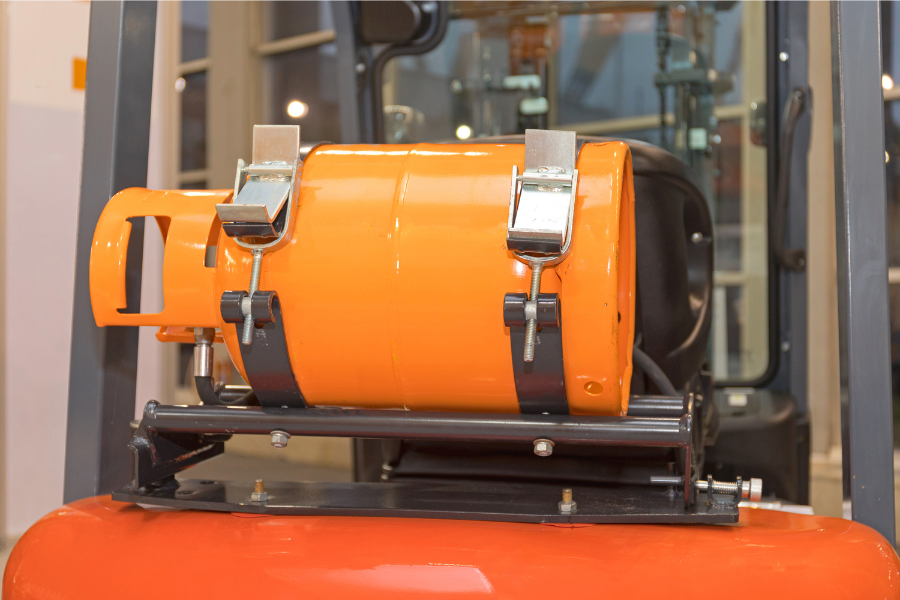For indoor heavy-lifting jobs, there is no better solution than electric-powered industrial trucks, since these machines do not produce exhaust. However, some industries require machines that can move between indoor and outdoor tasks, such as a propane-powered forklift.
Propane-powered forklifts run on liquid petroleum gas (LPG) stored in a fluid state in a high-pressure tank. The LPG forklift gas tank is not internal. Instead, the propane is stored in external tanks that are swapped when the truck needs refueling. Even though LPG does produce carbon monoxide and other pollutants when burned, the amount is less than both diesel- and gasoline-powered forklifts. This means LPG forklifts are sometimes used indoors, although only in areas with suitable ventilation.
Safety precautions for changing forklift propane tank
A propane tank is manufactured with safety features, such as shut-off mechanisms that activate the instant an accident is detected. However, that does not diminish the fact that propane is a flammable gas, and mishandling a tank could create a dangerous situation.
That’s why, before changing a forklift propane tank, it’s important to implement the following safety precautions.
Wear recommended personal protective equipment, such as safety gloves, glasses and steel-toe boots. Gloves protect your hands (propane tanks can get extremely cold during use), safety glasses protect your eyes from any errant gas or debris, and steel-toe boots help protect your feet should you mishandle the propane tank or another heavy object.
Make sure the forklift is parked on a flat, stable surface, away from sparks or other potential ignition sources. The area should be outdoors or well-ventilated to allow any leaked propane gas to dissipate.
Check that the engine is turned off and the key is removed from the ignition.
Before removing the tank, confirm that the valve on the tank is closed.
How to change a propane tank on a forklift
Changing a propane tank on a forklift is a straightforward process, but it can be dangerous and must be done carefully to avoid damaging the equipment. Only trained and authorized personnel should perform this task.
Step 1: Secure the forklift
Once the forklift is parked on a flat, outdoor or well-ventilated area with the engine off, set the parking brake so the forklift can’t move during the tank change.
Step 2: Close the valve on the propane tank
The propane tank’s valve is likely located near the connection to the forklift. Turn it clockwise to close it completely. This step prevents a dangerous amount of propane from escaping when the tank is disconnected.
Step 3: Disconnect the hose
The hose connects the forklift to the propane tank and allows propane to flow from the tank to the engine. Usually, it can be disconnected by hand, but you may need a small wrench to release the connection. Be careful because a small amount of gas may be released from the gas line when it is disconnected.
Step 4: Release the brackets
One or two brackets are used to secure the tank to the forklift. Don’t be surprised if they require some effort to undo.
Step 5: Remove the empty propane tank
Using two hands, carefully lift the propane tank from its mounting bracket. An empty forklift propane tank is not too heavy (the weight averages about 35 pounds, depending on size). However, it is sometimes awkward to remove them from the truck. Be sure to get some help, if necessary.
Step 6: Inspect the replacement tank and connections
Before installing a new tank, inspect it thoroughly for any signs of damage, such as dents, corrosion or leaks. Check that the valve is in good working condition and that the tank has been properly filled and certified. It’s also important to check the forklift’s hose and connection. Those parts can become bent and damaged during tank removal.
Step 7: Install the new propane tank
Lift the new propane tank carefully and place the new tank onto the forklift’s mounting bracket. Depending on size, a full forklift propane tank can weigh between 40 and 85 pounds. Please get assistance if needed. Once the tank is on the forklift, line up the slot in the tank collar with the screw in the bracket to lock it into place. Make sure the tank is fastened tight and will not move or shift during operation.
Step 8: Reconnect the hose
Start by making sure that the valve on the new tank is closed. (An open valve could cause gas to spray out.) Next, secure the hose by turning the connector in a clockwise direction. Make sure the connection is tight and secure, but do not overtighten because that can damage the threads and hose.
Step 9: Open the valve
Once the hose is connected, open the valve on the new propane tank by turning it counterclockwise. You should hear a slight hissing sound as propane begins to flow through the hose. This sound will stop once the system is pressurized.
Step 10: Check for leaks before starting the forklift
If the sound does not stop or you hear a rushing sound, smell “rotten eggs” or see white frost, you likely have a leak. You can also check for leaks by spraying a soapy water solution on the hose, valve and tank. If bubbles form, it indicates a leak. If you detect a leak, immediately close the valve, ventilate the area and address the issue before proceeding.
Forklift propane tank exchange
A forklift propane exchange is a service where suppliers swap empty propane tanks for full ones.
For a typical forklift tank exchange, a business collects its empty propane tanks in an accessible location and a service provider collects them. This can be done on a scheduled basis or as needed, depending on the company’s needs.
The collected tanks are taken to a facility where they are inspected, cleaned and recertified. Damaged tanks are repaired, if possible, or discarded. Then, the tanks are filled with propane and returned to the business.
How to fill forklift propane tank
It is possible to refill a propane tank. However, this task should only be performed by someone who is trained to safely use the specialized equipment.
Most businesses must transport their empty tanks to a refill forklift propane tank station. However, it may also be possible to find a company that offers on-site refilling.
Before filling forklift propane tanks, the service provider will inspect the tank for any signs of damage or wear. The empty tank is weighed to determine how much propane it can safely hold. Next, the operator at the fill forklift propane tank station will use a specialized nozzle to fill the tank with liquid propane. Then the tank is weighed again to ensure it was filled correctly.
While we’re sure there are many wonderful propane service providers, we know of only one stellar provider of best-in-class motive power solutions. It’s us: Texas Motive Solutions. We can help ensure that your material handling equipment operates at its best with our complimentary forklift fleet performance analysis. We provide top-of-the-line forklift batteries and accessories for all your forklift repair and battery needs. Please call us at (888) 316-2459 or fill out this form to learn about our services and discover everything that we can do for you.



